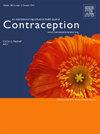异步远程医疗流产药物服务与患者的沟通。
IF 2.3
2区 医学
Q1 OBSTETRICS & GYNECOLOGY
引用次数: 0
摘要
前言:了解远程医疗流产患者与诊所提供者或工作人员的沟通可以为适当的人员配置提供信息。方法:我们描述了2020年4月至11月使用异步远程医疗流产服务时的患者服务沟通情况(n=504),并使用Kruskal-Wallis秩和检验比较了患者人口统计数据与消息数量。结果:约有一半的患者与医护人员沟通(56%,n= 287),平均每位患者6条信息(四分位数间距:3-10条信息)。主要主题包括1)资格,2)付款,3)药物递送,以及4)物理过程。信息量没有因患者人口统计而异。意义:我们的研究结果为远程医疗流产提供的沟通和人员数量和质量提供了信息。含义声明:异步远程医疗流产患者需要最少的沟通,大多数询问可以由非临床工作人员解决。这些见解可以为远程医疗堕胎服务的资源分配和人员配置决策提供信息,在保持患者满意度的同时提高效率。本文章由计算机程序翻译,如有差异,请以英文原文为准。
Communication with patients using asynchronous telehealth medication abortion services
Objectives
Understanding patient communication with clinic providers or staff in telemedicine abortion can inform appropriate staffing.
Methodology
We describe patient-service communication when using asynchronous telemedicine abortion services from April to November 2020 (n = 504) and compare patient demographics with number of messages using Kruskal-Wallis rank sum test.
Results
About half of patients communicated with staff (56%, n = 287), median of six messages per patient (interquartile range: 3–10 messages). Primary topics included (1) eligibility, (2) payment, (3) medication delivery, and (4) physical process. Message volume did not differ by patient demographics.
Conclusions
Our findings inform communication and staffing quantity and quality in telemedicine abortion provision.
Implications
Asynchronous telehealth abortion patients require minimal communication, and most inquiries can be addressed by nonclinical staff. These insights can inform resource allocation and staffing decisions in telehealth abortion services, improving efficiency while maintaining patient satisfaction.
求助全文
通过发布文献求助,成功后即可免费获取论文全文。
去求助
来源期刊

Contraception
医学-妇产科学
CiteScore
4.70
自引率
17.20%
发文量
211
审稿时长
69 days
期刊介绍:
Contraception has an open access mirror journal Contraception: X, sharing the same aims and scope, editorial team, submission system and rigorous peer review.
The journal Contraception wishes to advance reproductive health through the rapid publication of the best and most interesting new scholarship regarding contraception and related fields such as abortion. The journal welcomes manuscripts from investigators working in the laboratory, clinical and social sciences, as well as public health and health professions education.
 求助内容:
求助内容: 应助结果提醒方式:
应助结果提醒方式:


